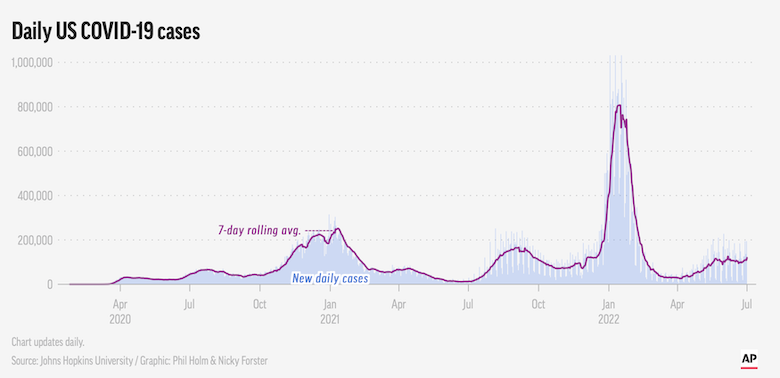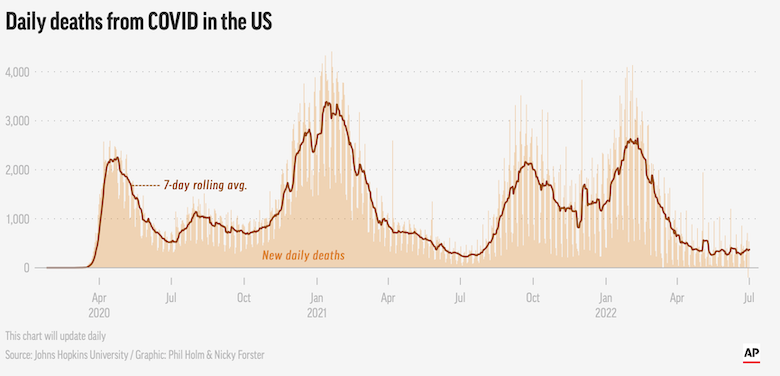The current pandemic has reached a strange state. On the one hand, people are still getting infected in large numbers. In the US, on average there are 100,000 cases per day and the true number is likely to be greater since so many people are now testing at home and may not be reporting positive results to the CDC.
On the other hand, the number of deaths has dropped quite a bit from its previous high, though it is still running around 360 per day.
Thanks to the vaccines and post-infection treatments, the fear of death has receded somewhat. This has resulted in people becoming more relaxed about taking precautions, such as wearing masks and avoiding crowded places.
With more Americans shielded from severe illness through vaccination and infection, COVID-19 has transformed – for now at least – into an unpleasant, inconvenient nuisance for many.
“It feels cautiously good right now,” said Dr. Dan Kaul, an infectious diseases specialist at the University of Michigan Medical Center in Ann Arbor. “For the first time that I can remember, pretty much since it started, we don’t have any (COVID-19) patients in the ICU.”
Pandemics never really go away. What happens is that the virus mutates into something less lethal that we take in our stride like we do the flu and colds. There is some cautious optimism thawe may be reaching that stage
The death rate for COVID-19 has been a moving target, but recently has fallen to within the range of an average flu season, according to data analyzed by Arizona State University health industry researcher Mara Aspinall.
At first, some people said coronavirus was no more deadly than the flu, “and for a long period of time, that wasn’t true,” Aspinall said. Back then, people had no immunity. Treatments were experimental. Vaccines didn’t exist.
Now, Aspinall said, the built-up immunity has driven down the death rate to solidly in the range of a typical flu season. Over the past decade, the death rate for flu was about 5% to 13% of those hospitalized.
Big differences separate flu from COVID-19: The behavior of the coronavirus continues to surprise health experts and it’s still unclear whether it will settle into a flu-like seasonal pattern.
There is still need for us to be on our guard.
Unvaccinated people have a six times higher risk of dying from COVID-19 compared with people with at least a primary series of shots, the CDC estimated based on available data from April.
This summer, consider your own vulnerability and that of those around you, especially in large gatherings since the virus is spreading so rapidly, Dowdy said.
“There are still people who are very much at risk,” he said.
While we may have feelings of irritation towards those who choose not to get vaccinated, we have to remember that there are people who for various medical reasons cannot get vaccinated. In addition to our own health, we owe it to them to be cautious. I for one am planning to continue to wear a mask and avoid crowds as before.
What we need to watch for is the coming winter, to see if a new variant emerges similar to the omicron one that caused such a huge spike in cases last winter.



I am a 55-year-old who is quite healthy, twice boosted, and has never, to my knowledge, been infected with covid. I am also a person who has to stay covid-free ahead of my hip replacement surgery in two weeks. I will be masking and avoiding crowds for the foreseeable future, thank you very much.
The UK’s surveillance program reports that 2.3 million people had COVID-19 in the week ending June 24th. Actually reported cases are about 1/20th of that, with deaths running a 400 a week (but death lag effects may be operating -- we were still, and may yet be, in the rising phase of the BA.4/5 wave). With the spotty nature of US vaccination I wouldn’t be surprised to find that US has a greater current CFR, but even so one suspects that the US is having several millions of infections per week.
Never forget (especially those who live in USAstan): Congress has blocked further funding for COVID-19 programs:
If we ignore the elderly who are still at elevated risk, and we ignore those with co-morbidities, and we ignore those who aren’t able to be vaccinated, and we ignore those who have been vaccinated but whose immune response has not been properly triggered, and we ignore the people who are suffering from the long-term debilitating effects of “long covid”, then the pandemic is over.
In our subconscious privilege, we only have to ignore a huge number of people.
Well, at least, generally-speaking, those who are wise enough to take what precautions they can for themselves and for others are not being significantly dissuaded from so doing.
(thin gruel, I know)